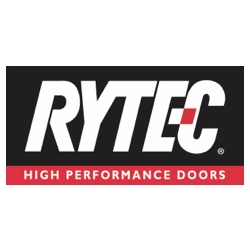Specifying high-performance rolling, folding, & fabric doors that wow
How to balance durability, quality, and aesthetics for industrial and commercial door applications
High-performance rolling doors must balance extreme durability, quality, safety, and aesthetics. AIA partner Rytec explains the criteria and what’s new in the category.

Rolling doors, fabric panels, thermoplastic, and other specialty doors are a staple in commercial and industrial applications, including parking garages, warehouses, mixed-use projects, and distribution facilities. And the latest high-performance doors offer an ideal combination of heavy-duty reliability, innovative design, and, yes, aesthetic appeal.
Here’s what to consider to ensure you’ve got a complete package that provides an unmistakable wow factor.
Quality construction
Rolling doors for parking, mixed-use, and other commercial applications should feature aluminum slat construction, which will eliminate the need for a security door. Some include integral weatherseals and heavy-duty hinge systems to provide even greater security. For other industrial applications, heavy-duty fabric, thermoplastic, and insulated door panel materials ensure proper environmental separation, energy efficiency, and years of long-lasting operation in production and distribution facilities.
Sophisticated appearance & modern aesthetics
The modern, crisp lines and high-quality materials used in today’s high-performance rigid rolling doors coordinate with many architectural styles. They can be designed with stylish, attractive door slats and other design elements that enhance the look of the parking garage and building. You can even take it an extra step with classic or custom-matched colors to further fit the visual appeal of individual structures, buildings, and architectural requirements. Similarly, fabric panel material can often coordinate with or complement customized interior and exterior applications, providing a consistent appearance or accentuating key access points.
Customizable panel features
Take performance aesthetics even further with versatile panel customizations that blend commercial functionality with residential, commercial, and environmental appeal. These include optional vision panels for two-way visibility and ventilated slats for enhanced airflow in addition to standard powder-coated slats. Also available are tinted vision slats that help reduce solar heat gain for installations in warmer climates. Some fabric models may also feature full-width or standard-sized vision panels for increased visibility and integral wind ribs for wind or pressure conditions.
Extreme-use durability
Some high-performance doors can withstand widely changing and harsh weather environments, from snow and salt to hurricanes. For example, limited models of high-performance doors are exclusively designed with hurricane-zone features such as heavy-duty reinforced hinges and aluminum slats that can withstand hurricane-force winds up to 175 miles per hour and impacts from small, wind-blown projectiles. Heavy-duty rubber doors are designed to withstand heavy equipment traffic and storage within the most extreme environments and feature thick SBR rubber panels, wind stops, and exclusive panel tensioning systems.
Multiple safety features
Safety is integrated into high-performance door functionality to minimize accidental impact events that could result in damage or injury. Common safety features often include:
- LED flashing threshold safety light strips or revolving traffic lights
- Audible warning devices
- Automatic edge sensors that reverse the door’s motion or prevent it from closing if the doorway is obstructed
- Motion or presence sensors that control open or close functionality if doorway traffic is detected
- Adjustable timers within door control panels
Virtually unlimited technology options
Unlike conventional doors, high-performance doors can be equipped with a variety of high-tech options, such as:
- Door control actuators that provide easy movement through the door threshold, reduce the chance of contact with the door, and control environment differentials with minimal open time
- Touchless door controls and activation systems to reduce the spread of bacteria and viruses
- Remote monitoring and management systems to open or close the door from anywhere, map multiple doors to easily set routes and priorities, and proactively initiate preventive maintenance and service schedules
- Multiple means of access control, including Bluetooth-based technology, mobile apps, wireless key fobs, and traditional key cards
- Cloud-based access management that allows controlled access rights based on building residents’ or users’ unique needs
- Programmable logic controllers (PLCs) to communicate with a variety of actuators/activators, including card readers, induction loops, remote controls, and push buttons
- Visual text displays to easily diagnose why a door won’t close, essential in parking applications where security is paramount or stations are unattended
Architectural resource availability
Modern high-performance doors typically play a featured role within the overall physical interior structure and exterior building envelope. As such, both 2D (CAD) renderings and 3D (BIM/Revit) models are key resources available from manufacturers to ensure construction accuracy and structural building compliance. These digital software files provide consistency and accuracy from planning and design to construction and installation to ensure proper door fit and maximum product operating life cycle.
Visit Rytec for their complete high-performance door product portfolio or the architects page for CAD, BIM/Revit, or other technical file access.
AIA does not sponsor or endorse any enterprise, whether public or private, operated for profit. Further, no AIA officer, director, committee member, or employee, or any of its component organizations in his or her official capacity, is permitted to approve, sponsor, endorse, or do anything that may be deemed or construed to be an approval, sponsorship, or endorsement of any material of construction or any method or manner of handling, using, distributing, or dealing in any material or product.

